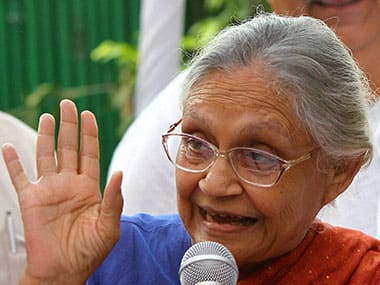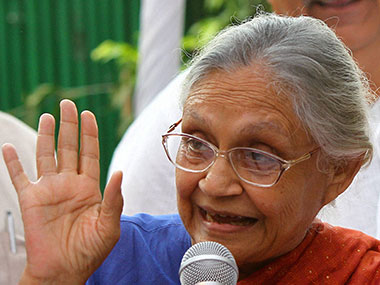In 2003, on a twin plank of governance and development, Sheila Dikshit, then 65, became the first Delhi Chief Minister to get a second successive term. She won with a two-thirds majority even as Congress governments in three other states were shown the door on an anti-incumbency wave. It was only upon her marriage into the family of former Union Minister Uma Shankar Dikshit that she was exposed to politics. (She married Dikshit’s son Vinod, an IAS officer.) [caption id=“attachment_127409” align=“alignleft” width=“380”]  Sheila Dikshit. PTI[/caption] Her first big assignment came when Indira Gandhi began to notice her while she was handling her father-in-law’s work. Gandhi nominated Sheila as a member of the Indian delegation to the UN Commission on the status of women. She was elected as an MP from Kannauj in Uttar Pradesh in 1984 and became a minister in Rajiv Gandhi’s government between 1986 and 1989. In 1998, she was appointed president of the Delhi Pradesh Congress Committee (DPCC), being given charge of a party that was riven by factionalism with just six months to go for Assembly polls. Nudged along by an anti-incumbency wave against the BJP government owing to a serious onion crisis in Delhi, Sheila’s Congress won 52 out of 70 seats that year. Good governance and infrastructure development have remained Sheila Dikshit’s keywords throughout the three terms she has enjoyed since. A big plank for her next election would be the introduction of the bhagidari (partnership) system with residents’ associations of Delhi in governnace decisions. The bhagidari system helped set right several Delhi ills – pollution, encroachments, traffic chaos and more. A variety of social welfare schemes focusing on pension for marginalised groups, an improved Public Distribution System are also among her achievements. The big downers in recent years – the 2010 Commonwealth Games corrruption scam, and the December 16 gangrape in Delhi and the outrage subsequently. In the case of the former, Sheila insisted that nothing has been proved, and in the latter she threw her hands up saying law and order was not in her hands and that she does not control the police. And then she didn’t cover herself in glory when she ventured to say that women in Delhi should not venture out after 8 pm. A Wall Street Journal profile of Sheila quotes Sidharth Mishra, author of “Capital Phenomenon,” a book about Delhi, as saying Dikshit gave subordinates “functional autonomy”. Her other big asset has been her networking with the legislative party. “Her main strength is her legislators, who she knows have good local connections,” Mishra is quoted as saying. From the Delhi Metro to a string of flyovers and from a brand new public transport system to accepting that the BRTS simply does not work for Delhi, she has put Delhi firmly on the global cities map. If India’s growth rate is 8.33 percent, Delhi’s has been 10.33 percent. On Sunday, however, the much-loved CM lost what was a chance to make history with a record fourth term.
The highs and lows of her 15 year tenure
Advertisement
End of Article


)
)
)
)
)
)
)
)
)



